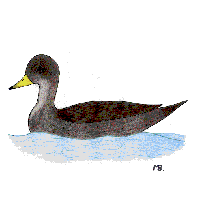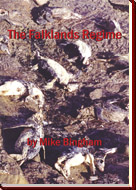 |
 |
| |
|
|
Yellow-billed Pintail Local Name: Grey Teal Breeding Range: Falkland Islands
and South America The Yellow-billed Pintail is not a very common bird in the Falklands, although it is fairly widespread. Individual pairs may be seen on freshwater ponds where they feed on aquatic invertebrates and vegetation. Nests of grass close to the water are lined with breast feathers, and 7 to 10 eggs are laid between September and December. Young take to the water at an early age, and collect their own food under the protection of the adults. Sexes are similar in appearance. The Yellow-billed Pintail can easily be confused with the Speckled Teal which is much smaller and more common. In addition to differences in size, the Pintail has a longer more slender neck, is much more timid, and is rarely found in groups which the Speckled Teal often is. |
|
|
||||||||||||||||||||||||||||




